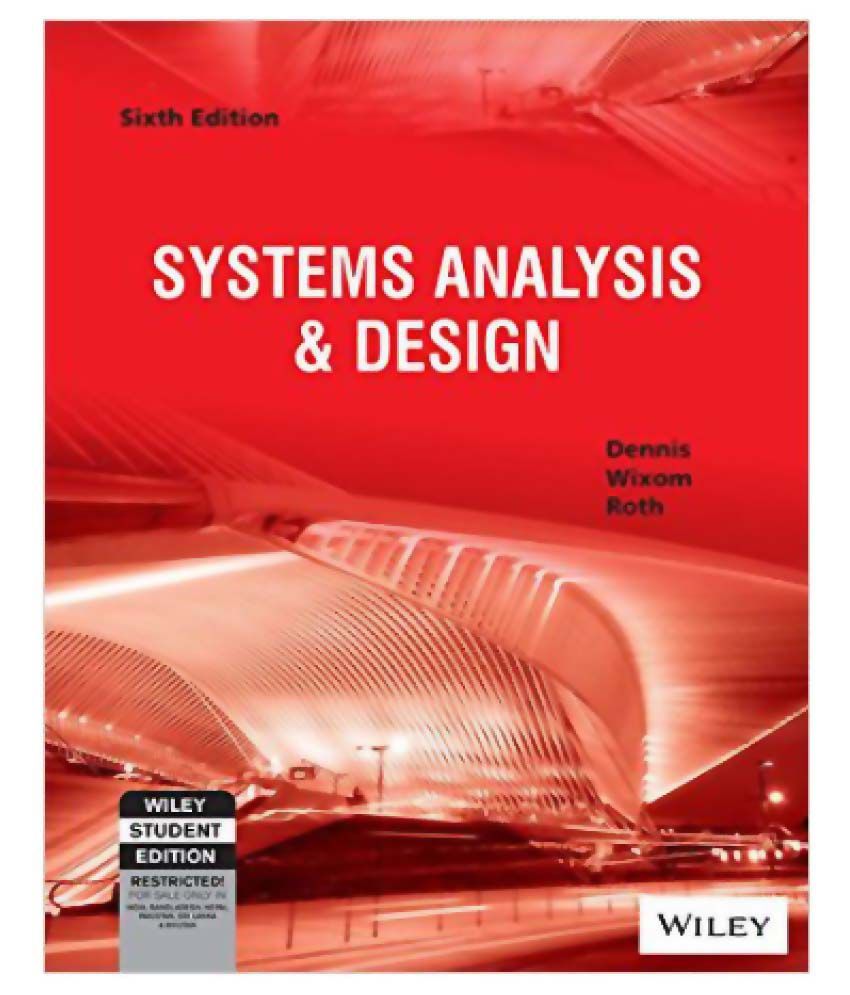Table Of Content

The approach is natural because people tend to think about things in terms of tangible objects and because many systems within an organization uses the same objects (i.e. windows, dialog boxes, menus, and buttons) the classes can be used repeatably. [8]Also, O-O analysis provides an easy transition to popular O-O programming languages, such as Java and C++. Systems Analysis and Design is an active field in which analysts repetitively learn new approaches and different techniques for building the system more effectively and efficiently. The primary objective of systems analysis and design is to improve organizational systems. This tutorial provides a basic understanding of system characteristics, system design, and its development processes. It is a good introductory guide that provides an overview of all the concepts necessary to build a system.
Structured / Waterfall[edit edit source]
The waterfall model is a popular version of the systems development life cycle approach that is considered farthest to the left on the predictive/adaptive scale for software engineering. Often considered the classic approach to the systems development life cycle, the waterfall model (mostly predictive) describes a development method that is linear and sequential. Waterfall development has distinct goals for each phase of development. Once a phase of development is completed, the development proceeds (drops over the waterfall) into the next phase and there is no turning back.
Dynamic System Models

In the modification waterfall model, phases of projects will overlap influencing and depending on each other. During this analysis phase, prototyping usually referred to as the discovery prototypes are very important because it is geared for understanding the users’ needs. [11] The prototypes are not built for full functionality but are built to see if the prototypes are feasible for what goals the business is trying to achieve. Sometimes, end users are trying to improve on the business processes or simplify a procedure.
In other languages
Interdependence means how the components of a system depend on one another. For proper functioning, the components are coordinated and linked together according to a specified plan. The output of one subsystem is the required by other subsystem as input.
Analysis of Construction Design That Would Aid In Disaster Management and Recovery - AZoBuild
Analysis of Construction Design That Would Aid In Disaster Management and Recovery.
Posted: Mon, 23 May 2022 07:00:00 GMT [source]
Once the problem is determined, and one or more solutions have been selected, planning to implement the solution begins. Multiple scenarios may be enacted to determine the best course of action for implementing the system. The users must know the main objective of a computer application early in the analysis for a successful design and conversion. The amount of support required may be determined based on the system.
Agribusiness systems analysis: origin, evolution and research perspectives - ScienceDirect.com
Agribusiness systems analysis: origin, evolution and research perspectives.
Posted: Mon, 04 Dec 2017 15:30:42 GMT [source]
Chapter 1 introduces the systems development life cycle (SDLC), the fundamental four-phase model (planning, analysis, design, and implementation) common to all information systems development projects. It describes the evolution of system development methodologies and discusses the roles and skills required of a systems analyst. The object-oriented approach has many benefits, they provide naturalness and reuse.
Systems Analysis and Design: Techniques, Methodologies, Approaches, and Architecture
If it is a large system involving many different departments, maintenance and support may be needed for a longer time. If is a smaller system, maintenance and support may only be needed for a short time. Although this section presents the information security components in a sequential top-down manner, the order of completion is not necessarily fixed. Security analysis of complex systems will need to be iterated until consistency and completeness is achieved. It is the arrangement of components that helps to achieve predetermined objectives. The word System is derived from Greek word Systema, which means an organized relationship between any set of components to achieve some common cause or objective.
Whereas structured analysis regards processes and data as separate components, object-oriented analysis combines data and the processes that act on the data into things called objects. Object-oriented analysis defines the different types of objects that are doing the work and interacting with one another in the system and by showing user interactions, called use cases, are required to complete tasks. Systems analysts use O-O methods to model real-world business processes and operations. The result is a set of software objects that represent actual people, things, transactions, and events. Using an O-O programming language, a programmer then transforms the objects into reusable code and components. However, on the right side of the predictive/adaptive scale we are able to make modifications in different phases; this is called a modified waterfall model.
Organization
Get Mark Richards’s Software Architecture Patterns ebook to better understand how to design components—and how they should interact. This section describes a number of security considerations that will help integrate information security into each phase of the SDLC. It is not uncommon for an organization to state an objective and operate to achieve another.
Once an application is in the testing stage, it is very difficult to go back and change something that was not well-thought out in the concept stage. This pure waterfall model makes it very difficult because there is no room for error and that is virtually impossible when dealing with humans. Use cases are widely used system analysis modeling tools for identifying and expressing the functional requirements of a system. Each use case is a business scenario or event for which the system must provide a defined response. The terms analysis and synthesis stems from Greek, meaning "to take apart" and "to put together", respectively.
The spiral life cycle is shown as a spiral model that begins with the planning phase first from the center (inward) of the spiral, eventually working its way outward, over and over again, until completion of the project. The planning phase will include activities such as feasibility study, a survey of user's requirements, overall design choice, generation of implementation alternative, and implementation strategy. The purpose of this phase is to have enough information to build a prototype. While practitioners of system analysis can be called upon to create new systems, they often modify, expand, or document existing systems (processes, procedures, and methods). Activity system analysis has been already applied to various research and practice studies including business management, educational reform, educational technology, etc. The advantage of waterfall development is that it allows for departmentalization and managerial control.
This section discusses the most popular methods for developing computer-based information systems. A popular, traditional method is called structured analysis, but a newer strategy called object-oriented analysis and design also is used widely. Each method offers many variations.Some organizations develop their own approaches or adopt methods offered by software vendors or consultants. Most IT experts agree that no single, best system development strategy exists. Instead, a systems analyst should understand the alternative methods and their strengths and weaknesses.

No comments:
Post a Comment